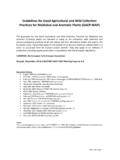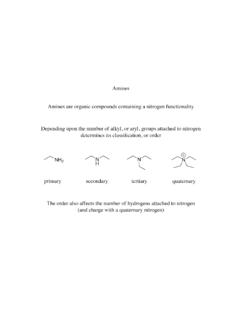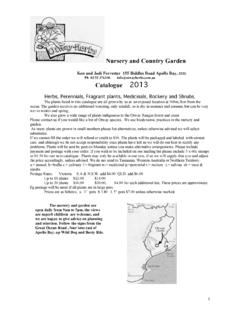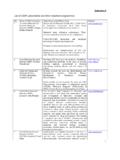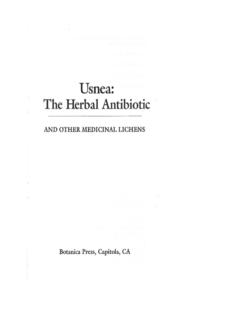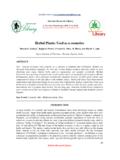Transcription of Introduction - WHO
1 Role of the WHO monographs on selected medicinal plantsThe first volume of the WHO monographs on selected medicinal plants , containing28 monographs, was published in 1999. It is gratifying that the importance ofthe monographs is already being recognized. For example, the European Com-mission has recommended volume 1 to its Member States as an authoritativereference on the quality, safety and efficacy of medicinal plants . The CanadianGovernment has also made a similar recommendation. Furthermore, as hoped,some of WHO s Member States, such as Benin, Mexico, South Africa and VietNam, have developed their own monographs based on the format of the monographs are not only a valuable scientific reference for healthauthorities, scientists and pharmacists, but will also be of interest to the generalpublic.
2 There can be little doubt that the WHO monographs will continue toplay an important role in promoting the proper use of medicinal plants through-out the of monographs for volume 2At the eighth International Conference on Drug Regulatory Authorities(ICDRA) held in Manama, Bahrain, in 1996, WHO reported the completion ofvolume 1 of the WHO monographs. Member States requested WHO to con-tinue to develop additional monographs. As a consequence, preparation of thesecond volume began in the preparation, the number of experts involved, in addition tomembers of WHO s Expert Advisory Panel on Traditional Medicine, signifi-cantly increased compared to that for volume 1.
3 Similarly, the numberof national drug regulatory authorities who participated in the preparation also greatly increased. This global network of active collaborators facilitatedwider access to the scientific references and information, thus increasing boththe quality and quantity of the monographs. These combined efforts greatlyimproved the efficiency of the preparation. As for volume 1, the monographswere drafted by the WHO Collaborating Centre for Traditional Medicine at theUniversity of Illinois at Chicago, United States of Second WHO Consultation on Selected medicinal plants was held inRavello-Salerno, Italy, in March 1999 to review and finalize the draft mono-graphs.
4 Twenty experts and drug regulatory authorities from WHO Member1 IntroductionStates participated (see Annex 1). Following extensive discussion, 30 of 31 draftmonographs were approved for volume 2. At the subsequent ninth ICDRA inBerlin, Germany in April 1999, the 30 draft monographs were presented, andMember States requested WHO to publish them as soon as and content of the monographsThe purpose of the monographs was clearly explained in the Introduction tovolume 1, and it is unnecessary to repeat it here.
5 However, it is important toemphasize that the word monograph , as appears in the title, is used as a tech-nical term only. These monographs are not intended to be official pharma-copoeial should also be stressed that this publication is not intended to replace offi-cial compendia such as pharmacopoeias, formularies or legislative , the descriptions included in the section on medicinal uses shouldnot be taken as implying WHO s official endorsement or approval. They merelyrepresent the systematic collection of scientific information available at the timeof preparation, for the purpose of facilitating information description of selected sections of the monographs is given in the Generaltechnical notices.
6 For easy reference, two cumulative indexes are also providedas annexes. Annex 2 lists the monographs in alphabetical order of the plantname, while Annex 3 is according to the plant material of Xiaorui ZhangActing CoordinatorTraditional MedicineDepartment of Essential Drugs and Medicines PolicyWorld Health OrganizationIntroduction2 General technical notices3 These WHO monographs are not pharmacopoeial monographs. Their pur-pose is to provide scientific information on the safety, efficacy and qualitycontrol/quality assurance of widely used medicinal plants , in order to facilitatetheir appropriate use in WHO s Member States; to provide models to assistWHO s Member States in developing their own monographs or formularies forthese and other herbal medicines.
7 And to facilitate information exchange amongWHO s Member format used for volume 2 essentially follows that of volume , to keep relevant sections together, Geographical distribution now pre-cedesDescription; and Dosage formsappears before the identity of the plant material of interest and theLatin binomial name of the source plant, the binomial name being the mostimportant criterion in quality assurance of the crude drug. Latin pharma-copoeial synonyms and vernacular names, listed in the sections SynonymsandSelected vernacular names, respectively, are those names used in commerce or bylocal consumers.
8 The monographs place outdated botanical nomenclature inthe synonyms category, based on the International rules of vernacular names listed are a selection of names from individual coun-tries worldwide, in particular from areas where the medicinal plant is incommon use. The lists are not complete, but reflect the names found at thetime of preparation in official monographs, reference books and the NaturalProducts Alert (NAPRALERT) database (a database of literature from aroundthe world on ethnomedical, biological and chemical information on medicinalplants, fungi and marine organisms, located at the WHO Collaborating Centrefor Traditional Medicine at the University of Illinois at Chicago, USA).
9 A detailed botanical description (in Description) is intended for quality assur-ance at the stages of production and collection of the source plant, whereas thedetailed description of the specific plant part used (the crude drug) inPlantmaterial of interest is for quality assurance at the manufacturing and commer-cial stages. Geographical distributionis not normally found in official compendia,but it is included here to provide additional quality assurance identity tests,Purity testsandChemical assaysare all normal compen-dial components included under those headings in these monographs.
10 Wherepurity tests do not specify accepted limits, those limits should be set in accor-dance with requirements of the respective national health medicinal plant and crude drug contains active or major chemical con-stituents with a characteristic profile that can be used for chemical qualitycontrol and quality assurance. These constituents are described in the sectionMajor chemical included in the section on medicinal usesshould not be takenas implying WHO s official endorsement or approval.










